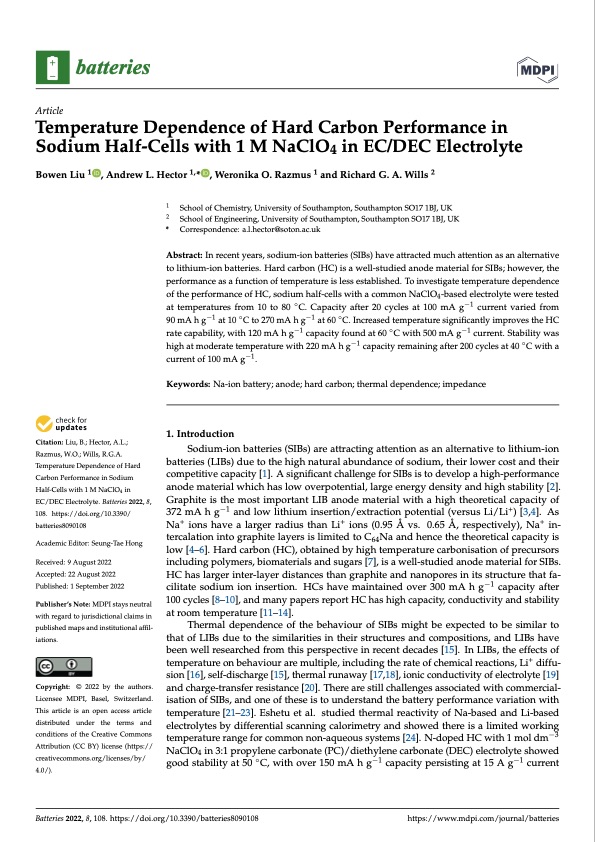
PDF Publication Title:
Text from PDF Page: 001
batteries Article Temperature Dependence of Hard Carbon Performance in Sodium Half-Cells with 1 M NaClO4 in EC/DEC Electrolyte Bowen Liu 1 , Andrew L. Hector 1,* , Weronika O. Razmus 1 and Richard G. A. Wills 2 Citation: Liu, B.; Hector, A.L.; Razmus, W.O.; Wills, R.G.A. Temperature Dependence of Hard Carbon Performance in Sodium Half-Cells with 1 M NaClO4 in EC/DEC Electrolyte. Batteries 2022, 8, 108. https://doi.org/10.3390/ batteries8090108 Academic Editor: Seung-Tae Hong Received: 9 August 2022 Accepted: 22 August 2022 Published: 1 September 2022 Publisher’s Note: MDPI stays neutral with regard to jurisdictional claims in published maps and institutional affil- iations. Copyright: © 2022 by the authors. Licensee MDPI, Basel, Switzerland. This article is an open access article distributed under the terms and conditions of the Creative Commons Attribution (CC BY) license (https:// creativecommons.org/licenses/by/ 4.0/). 1 2 Abstract: In recent years, sodium-ion batteries (SIBs) have attracted much attention as an alternative to lithium-ion batteries. Hard carbon (HC) is a well-studied anode material for SIBs; however, the performance as a function of temperature is less established. To investigate temperature dependence of the performance of HC, sodium half-cells with a common NaClO4-based electrolyte were tested at temperatures from 10 to 80 ◦C. Capacity after 20 cycles at 100 mA g−1 current varied from 90 mA h g−1 at 10 ◦C to 270 mA h g−1 at 60 ◦C. Increased temperature significantly improves the HC rate capability, with 120 mA h g−1 capacity found at 60 ◦C with 500 mA g−1 current. Stability was high at moderate temperature with 220 mA h g−1 capacity remaining after 200 cycles at 40 ◦C with a current of 100 mA g−1. Keywords: Na-ion battery; anode; hard carbon; thermal dependence; impedance 1. Introduction Sodium-ion batteries (SIBs) are attracting attention as an alternative to lithium-ion batteries (LIBs) due to the high natural abundance of sodium, their lower cost and their competitive capacity [1]. A significant challenge for SIBs is to develop a high-performance anode material which has low overpotential, large energy density and high stability [2]. Graphite is the most important LIB anode material with a high theoretical capacity of 372 mA h g−1 and low lithium insertion/extraction potential (versus Li/Li+) [3,4]. As Na+ ions have a larger radius than Li+ ions (0.95 Å vs. 0.65 Å, respectively), Na+ in- tercalation into graphite layers is limited to C64Na and hence the theoretical capacity is low [4–6]. Hard carbon (HC), obtained by high temperature carbonisation of precursors including polymers, biomaterials and sugars [7], is a well-studied anode material for SIBs. HC has larger inter-layer distances than graphite and nanopores in its structure that fa- cilitate sodium ion insertion. HCs have maintained over 300 mA h g−1 capacity after 100 cycles [8–10], and many papers report HC has high capacity, conductivity and stability at room temperature [11–14]. Thermal dependence of the behaviour of SIBs might be expected to be similar to that of LIBs due to the similarities in their structures and compositions, and LIBs have been well researched from this perspective in recent decades [15]. In LIBs, the effects of temperature on behaviour are multiple, including the rate of chemical reactions, Li+ diffu- sion [16], self-discharge [15], thermal runaway [17,18], ionic conductivity of electrolyte [19] and charge-transfer resistance [20]. There are still challenges associated with commercial- isation of SIBs, and one of these is to understand the battery performance variation with temperature [21–23]. Eshetu et al. studied thermal reactivity of Na-based and Li-based electrolytes by differential scanning calorimetry and showed there is a limited working temperature range for common non-aqueous systems [24]. N-doped HC with 1 mol dm−3 NaClO4 in 3:1 propylene carbonate (PC)/diethylene carbonate (DEC) electrolyte showed good stability at 50 ◦C, with over 150 mA h g−1 capacity persisting at 15 A g−1 current School of Chemistry, University of Southampton, Southampton SO17 1BJ, UK School of Engineering, University of Southampton, Southampton SO17 1BJ, UK * Correspondence: a.l.hector@soton.ac.uk Batteries 2022, 8, 108. https://doi.org/10.3390/batteries8090108 https://www.mdpi.com/journal/batteriesPDF Image | Temperature Dependence of Hard Carbon Sodium Half-Cells

PDF Search Title:
Temperature Dependence of Hard Carbon Sodium Half-CellsOriginal File Name Searched:
batteries_08_00108_v2.pdfDIY PDF Search: Google It | Yahoo | Bing
Salgenx Redox Flow Battery Technology: Salt water flow battery technology with low cost and great energy density that can be used for power storage and thermal storage. Let us de-risk your production using our license. Our aqueous flow battery is less cost than Tesla Megapack and available faster. Redox flow battery. No membrane needed like with Vanadium, or Bromine. Salgenx flow battery
| CONTACT TEL: 608-238-6001 Email: greg@salgenx.com | RSS | AMP |